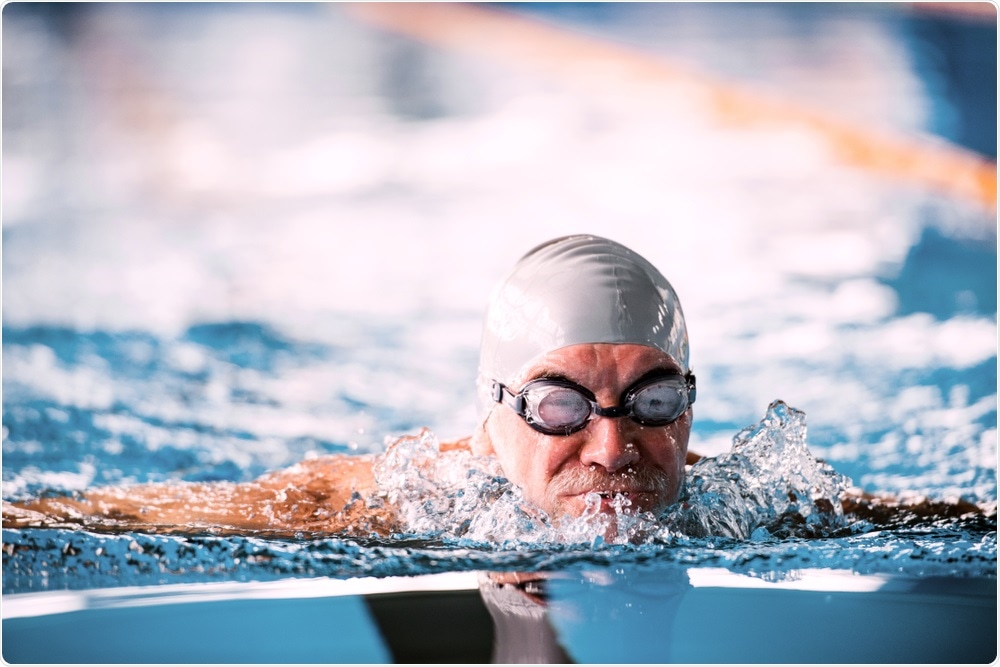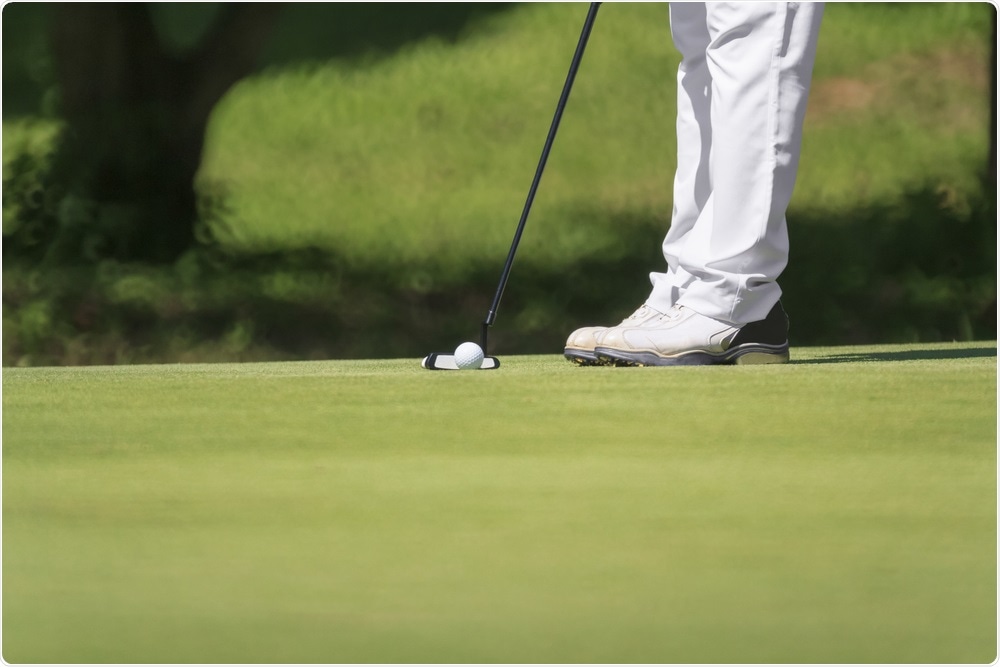Being physically active is an incredibly good way to protect against a lot of conditions which are more common in later life and which can be disabling: heart disease, stroke, type 2 diabetes, several cancers, poor mental health.
 Image Credit: Halfpoint / Shutterstock
Image Credit: Halfpoint / Shutterstock
People who do more physical activity live longer than those who do less and also have better quality of life and are less likely to have poor mobility, falls and to live independently in their own home rather than in a care setting.
What are the current recommendations for exercise in old age?
At present the UK guidelines recommend accumulating 150 minutes per week of moderate intensity activities, or 75 minutes per week of vigorous intensity activity (or a combination of the two), in bouts of 10 minutes or more.
They say that physical activity to improve muscle strength should be done on at least two days a week. Also, older adults at risk of falls should do physical activity to improve balance and co-ordination on at least two days a week.
Finally, all older adults should minimise the amount of time spent being sedentary (sitting) for extended periods.
Please describe your recent research in the field of sports medicine.
Most physical activity guidelines have used information about physical activity that participants had to recall, but it’s hard to remember all the physical activity that we do, especially light activity as this may include routine tasks.
In order to better understand how different intensities and patterns of activity are related to longevity, we recently did a prospective study using physical activity monitors which track how much the wearer moves and linked that to information about longevity over the next 5 years.
Critically, this allowed us to test the importance of hard to remember lighter intensity activities and also the importance of accumulating activity in bouts lasting 10 minutes or more.
 Image Credit: Devenorr / Shutterstock
Image Credit: Devenorr / Shutterstock
We used information from the British Regional Heart Study which recruited 7735 men (aged between 40 and 59 years) from primary care centres in 24 British towns in 1978-80.
In 2010-12, the 3137 surviving men were invited for a check-up which included a physical examination, and a questionnaire asking about their lifestyle, sleeping patterns, whether they had ever been diagnosed with heart disease.
The men were also asked to wear an accelerometer; a portable gadget that continuously tracks the volume and intensity of physical activity, during waking hours for 7 days. They were then followed up until June 2016 or death, whichever came first.
In all, 1566 (50%) men agreed to wear the device, but after excluding those with pre-existing heart disease and those with incomplete data, the final analysis included 1181 men, with an average age of 78 years.
We found that the total volume of physical activity, from light intensity upwards to moderate and vigorous activity, was associated with a lower risk of death from any cause.
For example, each additional 30 minutes a day of light intensity physical activity was associated with a 17 percent reduction in the risk of death.
The reduction in risk remained even after we took account of potentially influential lifestyle factors, such as sedentary time.
The equivalent reduction in the risk of death was around 33 percent for each additional 30 minutes of moderate to vigorous physical activity a day, meaning participants benefited greatly from more intense exercise.
We also found no evidence to suggest that accumulating moderate to vigorous activity in bouts lasting 10 minutes or more, which is the current recommendation, was better than accumulating it in shorter bouts.
What’s more, sporadic bouts seemed much easier for the participants to manage as two thirds (66 percent) of the men achieved their weekly total of moderate to vigorous activity in this way while only 16 percent managed to do so in bouts of 10 or more minutes.
Finally, there was no evidence to suggest that breaking up sitting time was associated with a lower risk of death.
What conclusions can be made from the research?
We concluded that the associations between light intensity activity and reduced risk of dying were large enough to mean that even light activity might prolong life in older men.
 Image Credit: Toa55 / Shutterstock
Image Credit: Toa55 / Shutterstock
This suggests that even modest amounts of activity may be beneficial in this older age range, so it’s important to do some activity even if the official target of 150 minutes of moderate to vigorous activity seems unachievable.
We also found greater benefits from more vigorous activities, so for those able to do the more intense activities, there were even greater benefits.
We found that there were large benefits to reaching the government recommended 150 minute weekly tally of moderate to vigorous activity, but that the way it was reached didn’t matter too much.
So the total time spent being active over the week (rather than absolutely needing to be active in 10 minute bouts, as current guidelines suggest) may be the key thing.
Of course there is a caution, this was an observational study and although it is a strong study design and we took steps to reduce the risk of reverse causality, no definitive conclusions can be drawn about cause and effect.
Also as those who wore the accelerometer tended to be younger and have healthier lifestyles than those who didn’t, this could have skewed the results.
Finally, it’s not clear if the findings would be equally applicable to older women, but based on other studies, we don’t have a strong reason to expect very different results for women.
Do you think that the current exercise recommendations need to be changed?
I think that it remains a good target to aim for 150 minutes each week of activity that is at last moderate intensity (that is, an activity that gets the heart pumping harder, but lets you still talk to a friend whilst doing the activity).
However, given that we know that the benefits of being active start at a lower level than 150 minutes per week, we could encourage older people who are unable to meet the 150 minute target, to at least do something: either a smaller amount of moderate activity eg 10-15 minutes per day instead of 30 minutes per day 5 times a week, or a similar amount (30 minutes per day) of lighter intensity activity.
I also think that in order to make the targets more accessible for older adults, it would be good to encourage them to be active irrespective of doing activity in bouts lasting 10 minutes or more, as we found that the pattern of accumulation of physical activity did not appear to affect mortality risks.
So future guidelines could emphasize that all physical activity, however modest, is worthwhile for extending the lifespan.
This is particularly important given that we know that physical activity levels decline rapidly with advancing age. That said, the more activity people can fit into their daily lives, the greater the benefits they will gain.
 Image Credit: cdrin / Shutterstock
Image Credit: cdrin / Shutterstock
What are the next steps for your research?
Having looked at all-cause mortality, we are now going to use similar methods to look at whether the different intensities of activity and patterns of activity are related to specific illnesses in old age, in order to better understand what recommendations about activity levels are useful for specific conditions.
Where can readers find more information?
Objectively measured physical activity, sedentary behaviour and all-cause mortality in older men: does volume of activity matter more than pattern of accumulation?
About Dr. Barbara Jefferis

Barbara Jefferis is an Associate Professor at University College London (UCL) in the Department of Primary Care and Population Health.
She received her BA from Oxford University, a Masters from the London School of Hygiene & Tropical Medicine and a PhD from University College London.
Her research focuses primarily on prevention of heart disease and stroke in older adults, with a particular emphasis on the preventive role of physical activity.